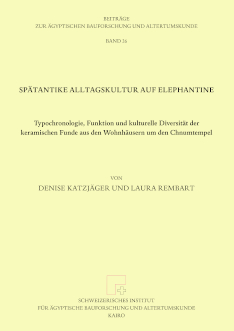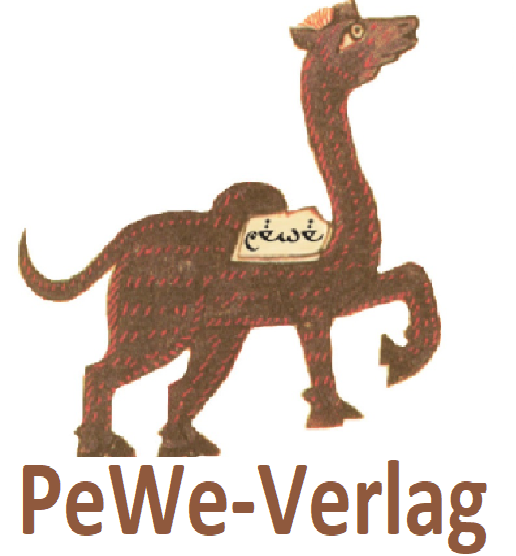
Denise Katzjäger / Laura Rembart
Spätantike Alltagskultur auf Elephantine.
Typochronologie, Funktion und kulturelle Diversität der keramischen Funde aus den Wohnhäusern um den Chnumtempel.
Beiträge zur ägyptischen Bauforschung und Altertumskunde, Band 26
Format: 35 x 24,5 cm — Hardcover
Umfang: 412 Seiten, 36 teils farbige Abbildungen und 600 unnummerierten Abbildungen im Katalogteil sowie 82 Farbtafeln
ISBN: 978-3-935012-65-2
Preis: 98,00 €
© PeWe-Verlag 2024
Elephantine gilt neben Syene/Assuan als südlichste Stadt des Römischen Reiches. Nicht nur als Grenzfestung zu Nubien, als Handelszentrum und Gauhauptstadt, sondern vor allem als eine der bedeutendsten religiösen Kultstätten des Alten Ägypten spielte die Insel über Jahrtausende hinweg eine wichtige Rolle. Um einen Einblick in das Alltagsleben der Bewohner von Elephantine und Syene zu erhalten, wurde vom Österreichischen Archäologischen Institut unter der Leitung von Sabine Ladstätter das Projekt „Antike Wohnkultur in Syene/Elephantine, Oberägypten“ initiiert, das in Zusammenarbeit mit dem Schweizerischen Institut für Ägyptische Bauforschung und Altertumskunde, Kairo durchgeführt wurde. Die vorliegende Publikation ist ein Teilbereich dieser Studie und beschäftigt sich mit der Auswertung des Keramikmaterials aus drei spätantiken Hauskomplexen auf Elephantine. Vorrangiges Ziel war die Eingrenzung der z.T. sehr langen Zeitspannen der Gefäßformen durch kritische Auseinandersetzung mit der Fachliteratur bzw. der Elephantine-Keramikforschung sowie die kontextuelle Auswertung und der Vergleich mit anderen Fundgruppen und damit das Aufzeigen von formtypologischen Entwicklungen und Funktionen der Gefäße. Darüber hinaus können Veränderungen in den Verzierungstechniken sowie die Genese der einzelnen Warengruppen erfasst werden. Eine Besonderheit des vorliegenden Materials stellt die lokal produzierte Feinkeramik dar, die vor allem seit der Spätantike überregionalen Absatz fand. Das im Rahmen des Projektes erarbeitete neue Fabrikatsystem konnte in Verbindung mit der in dieser Arbeit erarbeiteten Typologie Zusammenhänge zwischen Warengruppen, Formen und Fabrikaten aufzeigen. Anhand des keramischen Fundmaterials werden Aspekte der Alltagskultur Oberägyptens aufgezeigt und die kulturelle Vielfalt dieser Region im Hinblick auf Ess- und Trinkgewohnheiten sowie Handel beleuchtet.
Elephantine was the southernmost city of the Roman Empire, along with Syene/Aswan. For thousands of years, the island played an important role not only as a border fortress to Nubia, a trading centre and regional capital but also as one of the most important religious cult sites in ancient Egypt. In order to gain an insight into the everyday life of the inhabitants of Elephantine and Syene, the Austrian Archaeological Institute, under the direction of Sabine Ladstätter, initiated the project “ Housing in Antiquity in Syene/Elephantine, Upper Egypt“, which was carried out in cooperation with the Swiss Institute of Architectural and Archaeological Research on Ancient Egypt, Cairo. The present publication is part of this study and deals with the evaluation of ceramic material from three late antique house complexes at Elephantine. The primary aim was to narrow down the sometimes very long time spans of the vessel forms by critical analysis of the specialist literature and research on Elephantine pottery, as well as by contextual evaluation and comparison with other groups of finds. In addition, changes in decoration techniques and the genesis of individual ware groups can be recorded. Of particular interest in the available material is the locally produced fine ware, with supra-regional sales, especially from Late Antiquity onwards. The new fabric system developed in the course of the project, in conjunction with the typology developed in this work, has made it possible to show connections between ware groups, forms and production methods. The pottery finds are used to illustrate aspects of everyday culture in Upper Egypt and the cultural diversity of this region in terms of eating and drinking habits and trade.
